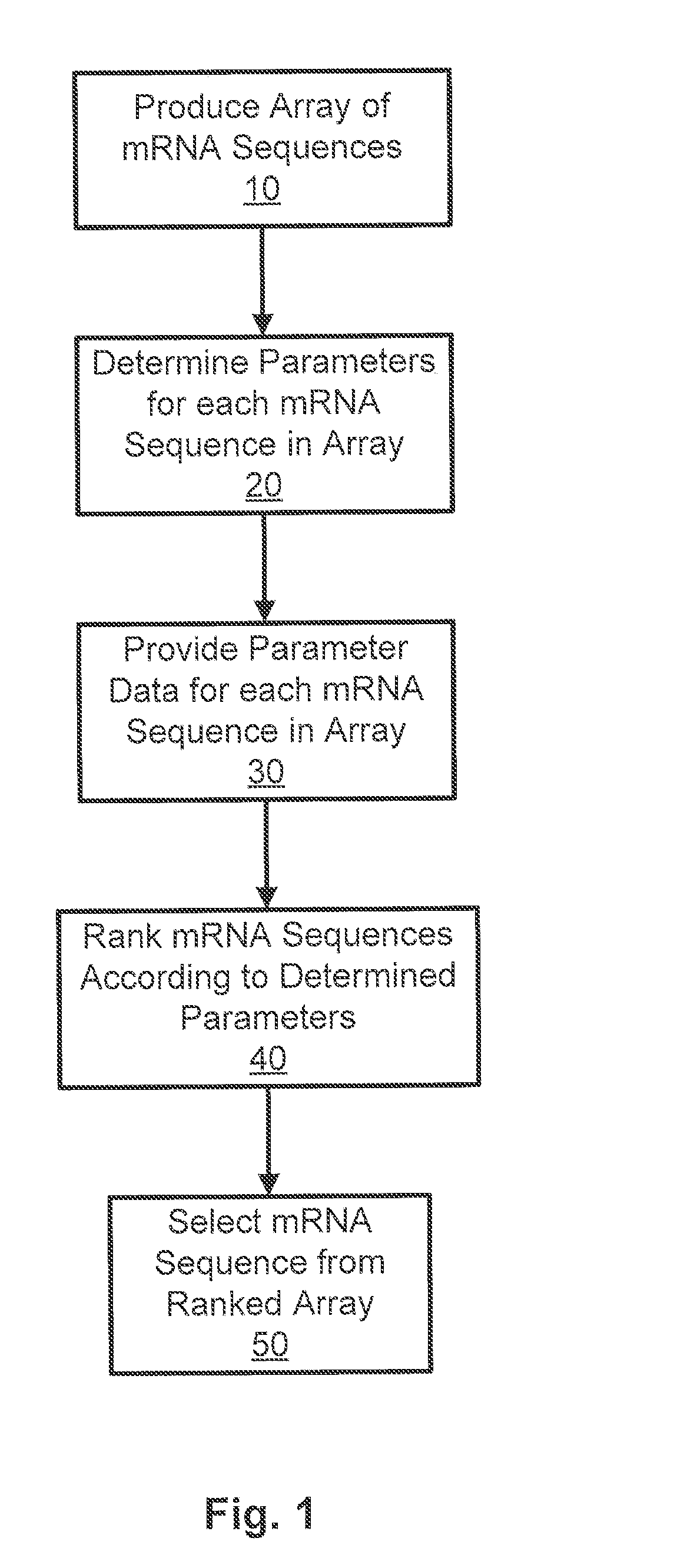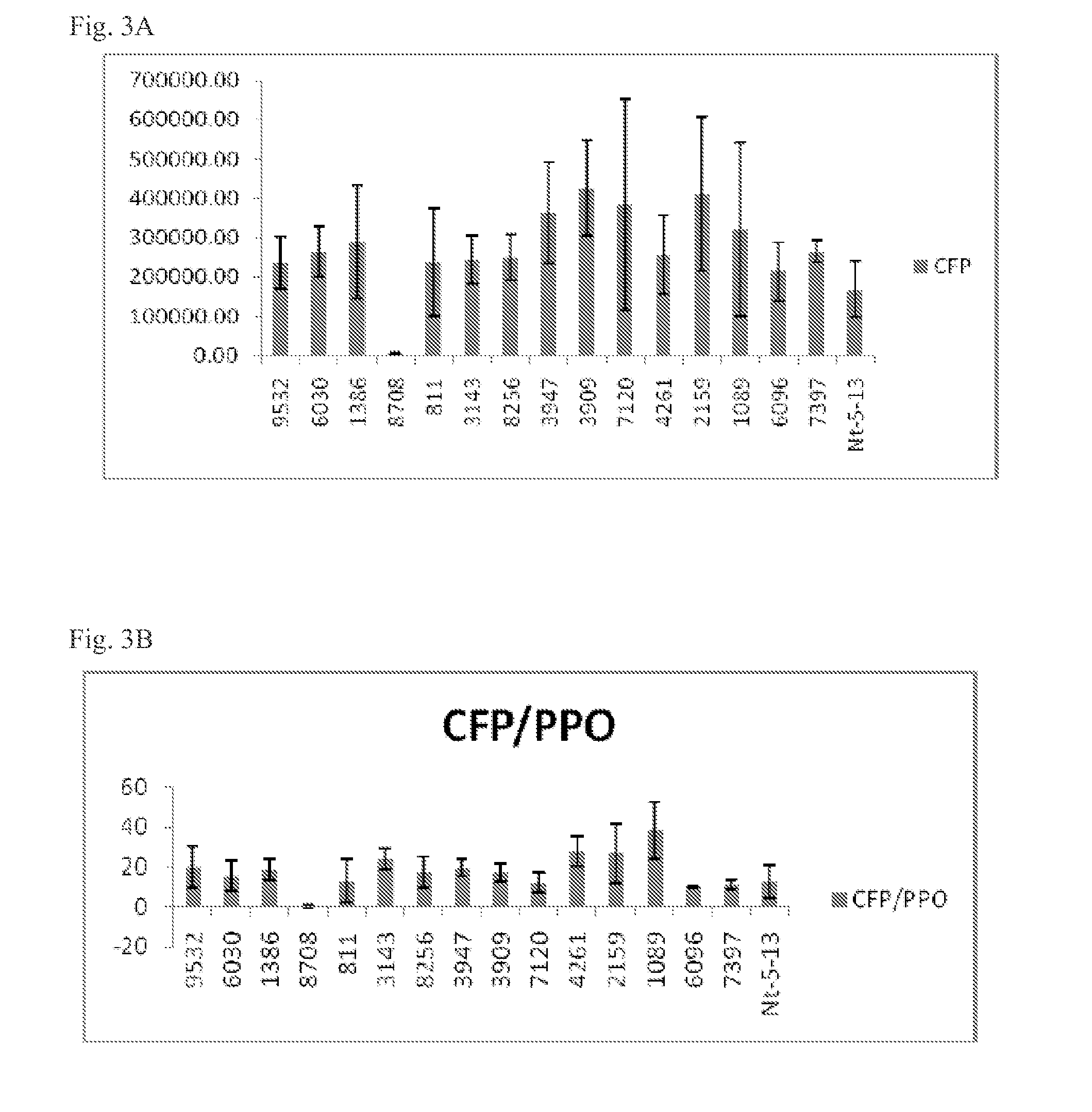Compositions and methods for protein production
a protein and protein technology, applied in the field of protein production, can solve the problem that no method has been devised that provides the level of predictability in protein production that is needed, and achieve the effects of reducing and enhancing the production of polypeptides
- Summary
- Abstract
- Description
- Claims
- Application Information
AI Technical Summary
Benefits of technology
Problems solved by technology
Method used
Image
Examples
example 1
Outline of Methods
[0185](1) Generation of RNA folding energies for potential sequences encoding a test amino acid sequence
(2) Selection of the variants (some that are predicted to express protein at high level while others are predicted to result in inefficient protein expression)
(3) Generation of vector constructs of each variant for yeast expression and for tobacco transient expression
(4) Transformation (e.g., yeast, tobacco, and corn)
(5) Quantitative RT-PCR used to estimate the level of mRNA transcript (to normalize data protein expression data and reduce possible influence of variation(s) in transcription level)
(6) Collection of samples for measuring level of protein expression
(7) Quantitative ELISA
[0186](8) Protein estimation to check the quality of the extract sample to be used in ELISA
(9) Western blot analysis to check for any possible post-translational modification of the expressed protein
(10) Data analysis to build a correlation between thermodynamic parameters of mRNA and...
example 2
Methods for Generation of RNA Folding Energies for Potential Sequences Encoding a Given Amino Acid Sequence
[0187]Starting with an input amino acid sequence, BioPerl was used to automate a random sampling procedure that generated nucleotide sequences encoding the input amino acid sequences. (Stajich et al. Genome Res 12(10):1611-8 (2002)). For each position in the amino acid sequence, codons for that position were selected by sampling the possible codons from a uniform distribution. Ten thousand nucleotide sequences were generated in this manner for each input amino acid sequence. Each output nucleotide sequence was checked for length and translation to ensure the accuracy of the sampling procedure. The ViennaRNA package version 1.8.2 was used to calculate for each input sequence the minimum free energy, ensemble free energy, and frequency of the MFE structure in the ensemble. (Hofacker et. al. Monatshefte f Chemie 125: 167-188 (1994); www.tbi.univie.ac.at / RNA / ). The parameter settin...
example 3
Selection of mRNA Variants (Both Enhanced and Reduced Protein Production)
[0188]The Anemonia majano cyan fluorescent protein (AmCyan reporter gene) with N-terminal chloroplast targeting signal polypeptide from Chlamydomonas reinhardtii and maize Zea mays EPSPS were chosen as polypeptides of interest. Selected mRNA variants were synthesized by GENEART® (Germany). Variants of the AmCyan nucleotide sequence were generated by replacing the coding sequence of the 5′ region (N-terminal region of the encoded polypeptide). Thus, in this particular example, 40 nucleotides from the 5′ end of the nucleotide sequence of the N-terminal signal peptide were replaced with the sequences (variants) set forth in Table 6 and / or Table 8, below.
[0189]Construct for Tobacco Transformation and Protein Expression.
[0190]A nucleic acid construct encoding the AmCyan nucleotide sequence (CFP) fused with the nucleotide sequence of a ssRubisco chloroplast transit peptide was used to transform tobacco. The nucleotid...
PUM
| Property | Measurement | Unit |
|---|---|---|
| pH | aaaaa | aaaaa |
| concentration | aaaaa | aaaaa |
| pH | aaaaa | aaaaa |
Abstract
Description
Claims
Application Information
 Login to View More
Login to View More - R&D
- Intellectual Property
- Life Sciences
- Materials
- Tech Scout
- Unparalleled Data Quality
- Higher Quality Content
- 60% Fewer Hallucinations
Browse by: Latest US Patents, China's latest patents, Technical Efficacy Thesaurus, Application Domain, Technology Topic, Popular Technical Reports.
© 2025 PatSnap. All rights reserved.Legal|Privacy policy|Modern Slavery Act Transparency Statement|Sitemap|About US| Contact US: help@patsnap.com



